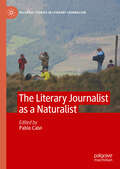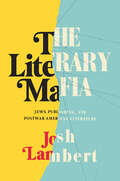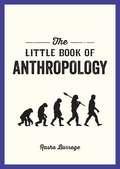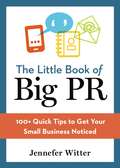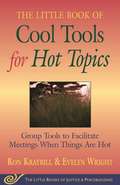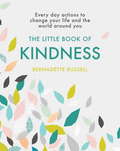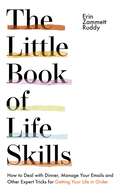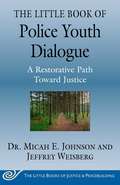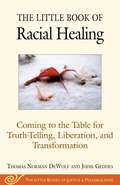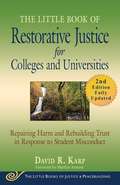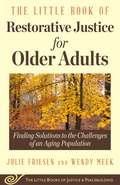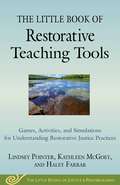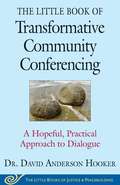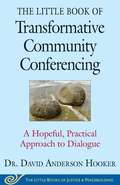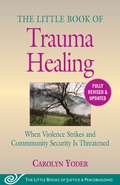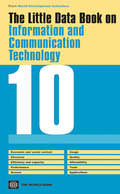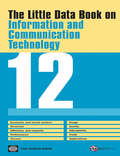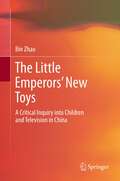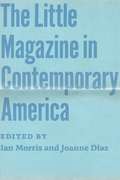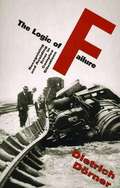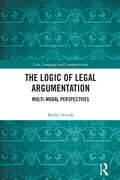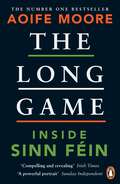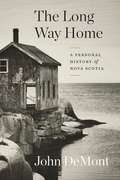- Table View
- List View
The Literary Journalist as a Naturalist (Palgrave Studies in Literary Journalism)
by Pablo CalviThis book is a scholarly anthology that proposes a deep discussion about the multiple ways in which narrative journalism has portrayed nature, human interactions with nature, the global actions and the consequences of activities that have either attempted to explore it, exploit it, harness it, dominate it, and protect it. This essay collection offers an academic framework for literary journalistic narratives about nature and includes the study of long form journalism originated in different corners of the world, all exploring human-non human-nature interactions in all their power, finitude, peril and urgency.
The Literary Mafia: Jews, Publishing, and Postwar American Literature
by Josh LambertAn investigation into the transformation of publishing in the United States from a field in which Jews were systematically excluded to one in which they became ubiquitous &“Readers with an interest in the industry will find plenty of insights.&”—Publishers Weekly &“From the very first page, this book is funnier and more gripping than a book on publishing has any right to be. Anyone interested in America&’s intellectual or Jewish history must read this, and anyone looking for an engrossing story should.&”—Emily Tamkin, author of Bad Jews In the 1960s and 1970s, complaints about a &“Jewish literary mafia&” were everywhere. Although a conspiracy of Jews colluding to control publishing in the United States never actually existed, such accusations reflected a genuine transformation from an industry notorious for excluding Jews to one in which they arguably had become the most influential figures. Josh Lambert examines the dynamics between Jewish editors and Jewish writers; how Jewish women exposed the misogyny they faced from publishers; and how children of literary parents have struggled with and benefited from their inheritances. Drawing on interviews and tens of thousands of pages of letters and manuscripts, The Literary Mafia offers striking new discoveries about celebrated figures such as Lionel Trilling and Gordon Lish, and neglected fiction by writers including Ivan Gold, Ann Birstein, and Trudy Gertler. In the end, we learn how the success of one minority group has lessons for all who would like to see American literature become more equitable.
The Little Book of Anthropology: A Pocket Guide to the Study of What Makes Us Human
by Rasha BarrageIf you’re intrigued by the question “What makes us human?”, strap in for this whirlwind tour of the highlights of anthropologyFrom the first steps of our prehistoric ancestors, to the development of complex languages, to the intricacies of religions and cultures across the world, diverse factors have shaped the human species as we know it. Anthropology strives to untangle this fascinating web of history to work out who we were in the past, what that means for human beings today and who we might be tomorrow.This pocket-sized introduction includes accessible primers on:Influential anthropologists such as Franz Boas, Margaret Mead and Ruth BenedictThe key branches of anthropology, from physical and linguistic anthropology to archaeologyHow anthropologists study topics such as communication, identity, sex and gender, religion and cultureHow we can approach one of life’s most enduring questions: what is it that truly makes us human?This illuminating little book will introduce you to the key thinkers, themes and theories you need to know to understand the development of human beings, and how our history has informed the way we live today. A perfect gift for anyone taking their first steps into the world of anthropology, as well as for those who want to brush up their knowledge.
The Little Book of Big PR: 100+ Quick Tips to Get Your Small Business Noticed
by Jennefer WitterAny size business can benefit from public relations. You can gain attention for your own small business and help build your company's credibility and brand . . . if you know the tricks of the trade. The Little Book of Big PR gives you essential advice on how to use public relations effectively as a business-building tool, whether you're an established company or a cost-conscious start-up. Drawing on the expertise gained during her long career in public relations, Jennefer Witter shares simple, smart, and budget-friendly methods for getting your business noticed. The book concisely covers the seven key elements of public relations, including: Self-Branding: Communicate who you are, what you do, and how you differ from others, highlighting your own uniqueness to give you a distinct advantage over your competition. Media Relations: Working with the press involves targeting the right outlets, in exactly the right way. This book tells you how to craft a perfect pitch, when to follow up, and what not to do when dealing with reporters. Social Media: Find out which social media are most effective for small business owners; what to post and where; and how to integrate social media into your strategy to widen your audience, and ultimately, the opportunity to generate additional revenue. And more . . . The book features quick tips on key topics including networking, speaking engagments, and how to select a PR agency---should you choose to work with one. The book also includes real-world case studies and sample content (such as media pitches) to use as-is or to modify to fit your own specific needs. As an entrepreneur, you need every helpful tool you can get your hands on! Now you're armed with the very same tactics the PR pros use, giving you the expert guidance you need to help grow your business to new, attention-getting heights.
The Little Book of Cool Tools for Hot Topics: Group Tools to Facilitate Meetings When Things Are Hot
by Evelyn Wright Ron KraybillLead author Ron Kraybill is a professor of Conflict Studies in the Conflict Transformation Program at Eastern Mennonite University, Harrisonburg, Virginia. During the years of the South African political transition, he trained local, regional, and national leadership in negotiation and mediation skills and served as a training advisor to the National Peace Accord. Cool Tools is rich in anecdotes and practical how-to for any group faced with tension-filled decision-making.
The Little Book of Kindness: Everyday actions to change your life and the world around you
by Bernadette RussellThe Little Book of Kindness will teach you how to be kind to yourself, to strangers, to those you love, to the world - every day, at every opportunity. Prompted by the seeming hopelessness of the world around her, Bernadette Russell undertook a pledge to be kind to a stranger every day for a year. The experience left her wanting to inspire others. The Little Book of Kindness is packed with fun ideas, practical tips and interactive exercises that encourage you to 'be kind' in every area of life - online, to strangers, to the environment, in your community, to yourself - and change the world, one act of kindness at a time.
The Little Book of Life Skills: How to Deal with Dinner, Manage Your Emails and Other Expert Tricks for Getting Your Life In Order
by Erin Zammett RuddyWith tips from leading experts in every field, The Little Book of Life Skills is the ultimate guide to solving the trickiest tasks in your day, making life easier with more time to do things that bring you joy.We all have areas of our lives that make us feel disorganised, unprepared or stressed out. From creating a calmer morning routine to setting yourself up for a good night's sleep, and everything in between, there are easy and proven ways to do things better. Whether you need advice on how to end an argument, iron a shirt or keep your inbox under control, Erin has spoken to experts including Arianna Huffington, Gretchen Rubin, Rachael Ray and Dr Oz, and condensed their wisdom into easy to follow steps for all of life's simple and not-so-simple tasks, such as:- Working from home effectively- Keeping a houseplant alive- Unplugging from your phone- Walking into a room with confidence, and many moreThe Little Book of Life Skills offers simple strategies for streamlining your life. It's the perfect guide for anybody who wants to get their life in order, be more efficient throughout the day and finally learn the best way to fold that tricky fitted sheet!*Featured on Deliciously Ella: The Podcast - 10 Ways to De-Stress Your Life*'If you've ever struggled with making a great cheeseboard, exiting a party gracefully or keeping a houseplant alive (um, guilty!), this is the book for you!' - Rachel Ray'A really interesting read that you will turn to again and again.' - Woman's Way
The Little Book of Police Youth Dialogue: A Restorative Path Toward Justice (Justice and Peacebuilding)
by Dr. Micah E. Johnson Jeffrey WeisbergDiscover the police-youth dialogue (PYD) as a method to build trustworthiness, mend relationships, and heal historical harms between black youth and law enforcement. This timely book from the Justice and Peacebuilding series offers an explanation of the need for meaningful dialogue between law enforcement and black youth, a blueprint for implementing police-youth dialogues, best practices and examples, anecdotes and narratives from participants, different models and formats, potholes and limitations, and tangible tools and action steps for starting a police-youth dialogue program. Ultimately, the strategies and techniques used in effective police-youth dialogues can bring attention to issues of implicit bias and the impact of toxic stress on marginalized groups, ameliorate tensions between law enforcement officers and black youth, and build toward a model of community policing and restorative justice rather than punitive discipline and violence.The Little Book of Police-Youth Dialogue presents readers with relevant knowledge and research regarding trauma and race in the United States, strategies for creating a safe space of attentive listening and mediating genuine connections between police officers and black youth, and specific ways to take action in ameliorating police-youth tensions and promoting healing in their local communities.
The Little Book of Racial Healing: Coming to the Table for Truth-Telling, Liberation, and Transformation (The Little Books of Justice and Peacebui #1)
by Thomas Norman Dewolfe Geddes JodiePeople of color, relative to white people, fall on the negative side of virtually all measurable social indicators. The “living wound” is seen in the significant disparities in average household wealth, unemployment and poverty rates, infant mortality rates, access to healthcare and life expectancy, education, housing, and treatment within, and by, the criminal justice system. Coming to the Table (CTTT) was born in 2006 when two dozen descendants from both sides of the system of enslavement gathered together at Eastern Mennonite University (EMU), in collaboration with the Center for Justice & Peacebuilding (CJP). Stories were shared and friendships began. The participants began to envision a more connected and truthful world that would address the unresolved and persistent effects of the historic institution of slavery. This Little Book shares Coming to the Table’s vision for the United States—a vision of a just and truthful society that acknowledges and seeks to heal from the racial wounds of the past. Readers will learn practical skills for better listening; discover tips for building authentic, accountable relationships; and will find specific and varied ideas for taking action.
The Little Book of Restorative Justice for Colleges and Universities, Second Edition: Repairing Harm and Rebuilding Trust in Response to Student Misconduct (Justice and Peacebuilding)
by David R. KarpA Practitioner's Reference and Guide to Implement Restorative Justice on CampusHere’s a call to colleges and universities to consider implementing restorative practices on their campuses, ensuring fair treatment of students and staff while minimizing institutional liability, protecting the campus community, and boosting morale, from an associate dean of student affairs who has put these models to work on his campus.Restorative justice is a collaborative decision-making process that includes victims, offenders, and others who are seeking to hold offenders accountable by having them (a) accept and acknowledge responsibility for their offenses, (b) to the best of their ability, repair the harm they caused to victims and communities, and (c) work to reduce the risk of re-offense by building positive social ties to the community. David Karp writes in his introduction, “As a student affairs administrator, I have become deeply committed to the concept and practice of restorative justice. I have experienced how it can work given the very real pressures among campus conduct administrators to manage high case loads, ensure fair treatment, minimize institutional liability, protect the campus community, boost morale in a division with high turnover, and help students learn from their mistakes without creating insurmountable obstacles to their future successes.”
The Little Book of Restorative Justice for Older Adults: Finding Solutions to the Challenges of an Aging Population (Justice and Peacebuilding)
by Julie Friesen Wendy MeekExploring Restorative Justice Practices as a Compelling Response to the Challenges of an Aging Population As our global population ages, conflicts and difficult conversations emerge. How will older adults decide who will make end-of-life health and financial decisions for them? When will dad need to move out of his home and into long-term care? We can’t have mom living with us anymore because it’s just too hard. Why are my children fighting over where I will live? Why is my son taking money from me? These are challenging scenarios that ever-increasing numbers of people are facing. Sometimes these difficulties are discussed in catastrophic terms:Untenable health-care costs Exhausted pension funds Crises in home-care and long-term housing And other concerns Certainly, there are some reasons to worry; however, the challenges facing older adults can be an opportunity for positive change. The Little Book of Restorative Justice for Older Adults is about providing safe and respectful processes to assist in resolving conflict and addressing abuse involving older adults, families, caregivers, and communities. Authors Julie Friesen and Wendy Meek explore ideas to help connect and support people, building on the strengths and capacities of older adults and their families, in order to strengthen communities. Restorative justice dialogues help older adults and their families talk constructively and safely to find ways to move forward together.
The Little Book of Restorative Teaching Tools: Games, Activities, and Simulations for Understanding Restorative Justice Practices (Justice and Peacebuilding)
by Lindsey Pointer Kathleen McGoey Haley FarrarEngaging Practices for Integrating Restorative Justice Principles in Group Settings As restorative practices spread around the world, scholars and practitioners have begun to ask very important questions: How should restorative practices be taught? What educational structures and methods are in alignment with restorative values and principles? This book introduces games as an effective and dynamic tool to teach restorative justice practices. Grounded in an understanding of restorative pedagogy and experiential learning strategies, the games included in this book provide a way for learners to experience and more deeply understand restorative practices while building relationships and improving skills. Chapters cover topics such as:Introduction to restorative pedagogy and experiential learningHow a restorative learning community can be built and strengthened through the use of games and activitiesHow to design games and activities for teaching restorative practicesHow to design, deliver, and debrief an activity-based learning experienceIn-depth instructions for games and activities for building relationships, understanding the restorative philosophy, and developing skills in practiceAn ideal handbook for educators, restorative justice program directors and trainers, consultants, community group leaders, and anyone else whose work draws people together to resolve disagreements or address harm, this book will serve as a catalyst for greater creativity and philosophical alignment in the teaching of restorative practices across contexts.
The Little Book of Transformative Community Conferencing: A Hopeful, Practical Approach to Dialogue
by David Anderson HookerWhen conflicts become ingrained in communities, people lose hope. Dialogue is necessary but never sufficient, and often actions prove inadequate to produce substantial change. Even worse, chosen actions create more conflict because people have different lived experiences, priorities, and approaches to transformation. The Little Book Transformative Community Conferencing will be valuable to mediators, restorative justice practitioners, community organizers, as well as leaders of peacebuilding and change efforts. It presents an important addition to the study and practice of strategic peacebuilding, restorative justice, conflict transformation, trauma healing, and community organizing.
The Little Book of Transformative Community Conferencing: A Hopeful, Practical Approach to Dialogue (Justice and Peacebuilding)
by David Anderson HookerWhen conflicts become ingrained in communities, people lose hope. Dialogue is necessary but never sufficient, and often actions prove inadequate to produce substantial change. Even worse, chosen actions create more conflict because people have different lived experiences, priorities, and approaches to transformation. So what’s the story?In The Little Book of Transformative Community Conferencing, David Anderson Hooker offers a hopeful, accessible approach to dialogue that:Integrates several practice approaches including restorative justice, peacebuilding, and artsCreates welcoming, non-divisive spaces for dialogueNames and maps complex conflicts, such as racial tensions, religious divisions, environmental issues, and community development as it narrates simple storiesBuilds relationships and foundations for trust needed to support long-term community transformation projectsAnd results in the crafting of hopeful, future-oriented visions of community that can transform relationships, resource allocation, and structures in service of communities’ preferred narratives.The Little Book Transformative Community Conferencing will prove valuable and timely to mediators, restorative justice practitioners, community organizers, as well as leaders of peacebuilding and change efforts. It presents an important, stand-alone process, an excellent addition to the study and practice of strategic peacebuilding, restorative justice, conflict transformation, trauma healing, and community organizing.This book recognizes the complexity of conflict, choosing long-term solutions over inadequate quick fixes. The Transformative Community Conferencing model emerges from the author’s thirty years of practice in contexts as diverse as South Sudan; Mississippi; Greensboro, North Carolina; Oakland, California; and Nassau, Bahamas.
The Little Book of Trauma Healing: When Violence Strikes and Community Security Is Threatened (Justice and Peacebuilding)
by Carolyn YoderHow do we address trauma, interrupt cycles of violence, and build resilience in a turbulent world of endless wars, nationalism, othering, climate crisis, racism, pandemics, and terrorism? This fully updated edition offers a practical framework, processes, and useful insights.The traumas of our world go beyond individual or one-time events. They are collective, ongoing, and the legacy of historical injustices. How do we stay awake rather than numbing or responding violently? How do we cultivate individual and collective courage and resilience? This Little Book provides a justice-and-conflict-informed community approach to addressing trauma in nonviolent, neurobiologically sound ways that interrupt cycles of violence and meet basic human needs for justice and security. In these pages, you&’ll find the core framework and tools of the internationally acclaimed Strategies for Trauma Awareness and Resilience (STAR) program developed at Eastern Mennonite University&’s Center for Justice and Peacebuilding in response to 9/11. A startlingly helpful approach.
The Little Book on Legal Writing
by Alan L. DworskyThis book is geared to the kind of writing first-year law students do in a standard legal writing course: memorandums and briefs. However, almost all the advice given applies to other kinds of legal writing as well, such as contracts and pleadings. In fact, much of the advice applies to nonfiction writing in general, because good legal writing is simply good writing. Each subject is broken down into simple, concise sections, making The Little Book on Legal Writing an excellent title for any professor s legal writing course.
The Little Data Book on Information and Communication Technology 2010
by World BankThis Little Data Book presents at-a-glance tables for over 140 economies showing the most recent national data on key indicators of information and communications technology (ICT), including access, quality, affordability, efficiency,sustainability, and applications.
The Little Data Book on Information and Communication Technology, 2012
by The World BankThis Little Data Book presents tables for over 213 economies showing the most recent national data on key indicators of information and communications technology (ICT), including access, quality, affordability, efficiency,sustainability, and applications.
The Little Emperors’ New Toys
by Bin ZhaoDrawing on original research I conducted in the late 1980s, the book argues for a critical approach to the study of children and television. It begins with critical reappraisals of previous empiricist and interpretative studies to set the ground for a different theoretical inquiry which links biography with history. The situated activity of children's television viewing therefore has to be related to the broader historical and cultural formations in post-Mao China. By way of a methodological pluralism of questionnaire survey, in-depth interviews and observation, the book provides the reader with a thorough critical analysis of the rise of the new commercial ethic in Chinese society in general, and in the sector of media and communications in particular, at the very historical turning point of the late 1980s. Soon after that, Deng Xiaoping made his significant tour to south China, reckoning a big step forward towards further liberalization and started to form a brave new world in China ever since.
The Little Magazine in Contemporary America
by Ian Morris Joanne DiazLittle magazines have often showcased the best new writing in America. Historically, these idiosyncratic, small-circulation outlets have served the dual functions of representing the avant-garde of literary expression while also helping many emerging writers become established authors. Although changing technology and the increasingly harsh financial realities of publishing over the past three decades would seem to have pushed little magazines to the brink of extinction, their story is far more complicated. In this collection, Ian Morris and Joanne Diaz gather the reflections of twenty-three prominent editors whose little magazines have flourished over the past thirty-five years. Highlighting the creativity and innovation driving this diverse and still vital medium, contributors offer insights into how their publications sometimes succeeded, sometimes reluctantly folded, but mostly how they evolved and persevered. Other topics discussed include the role of little magazines in promoting the work and concerns of minority and women writers, the place of universities in supporting and shaping little magazines, and the online and offline future of these publications. Selected contributors Betsy Sussler, BOMB; Lee Gutkind, Creative Nonfiction; Bruce Andrews, L=A=N=G=U=A=G=E; Dave Eggers, McSweeney’s; Keith Gessen, n+1; Don Share, Poetry; Jane Friedman, VQR; Amy Hoffman, Women’s Review of Books; and more.
The Logic of Connective Action
by W. Lance Bennett Alexandra SegerbergThe Logic of Connective Action explains the rise of a personalized digitally networked politics in which diverse individuals address the common problems of our times such as economic fairness and climate change. Rich case studies from the United States, United Kingdom, and Germany illustrate a theoretical framework for understanding how large-scale connective action is coordinated using inclusive discourses such as "We Are the 99%" that travel easily through social media. In many of these mobilizations, communication operates as an organizational process that may replace or supplement familiar forms of collective action based on organizational resource mobilization, leadership, and collective action framing. In some cases, connective action emerges from crowds that shun leaders, as when Occupy protesters created media networks to channel resources and create loose ties among dispersed physical groups. In other cases, conventional political organizations deploy personalized communication logics to enable large-scale engagement with a variety of political causes. The Logic of Connective Action shows how power is organized in communication-based networks, and what political outcomes may result.
The Logic of Failure: Recognizing and Avoiding Error in Complex Situations
by Dietrich DornerWhy do we make mistakes? Are there certain errors common to failure, whether in a complex enterprise or daily life? In this truly indispensable book, Dietrich Dörner identifies what he calls the “logic of failure”—certain tendencies in our patterns of thought that, while appropriate to an older, simpler world, prove disastrous for the complex world we live in now. Working with imaginative and often hilarious computer simulations, he analyzes the roots of catastrophe, showing city planners in the very act of creating gridlock and disaster, or public health authorities setting the scene for starvation. The Logic of Failure is a compass for intelligent planning and decision-making that can sharpen the skills of managers, policymakers and everyone involved in the daily challenge of getting from point A to point B.
The Logic of Legal Argumentation: Multi-Modal Perspectives (Law, Language and Communication)
by Marko NovakMulti-modal argumentation with its logical, emotional, visceral and kisceral arguments is an important addition to logical argumentation, especially when real-life situations are considered. It does not discard logic but adds other modes of argumentation to complement it, to emphasize the realistic environments of communication. In this sense, the multi-modal theory is important for the area of legal argumentation, where even in the reasoning of judicial decisions traces of a flesh-and-blood personality, who decided the case and wrote the reasons, can be found. This book presents a comprehensive analysis of this informal logic in legal argumentation and its practicality within the law. It argues that by building on the dialectical and rhetorical models of legal argument, the former being important for clear cases while the latter for unclear ones, the multi-modal theory of legal argumentation brings together logic and psychology in a holistic or integral perspective. The approach is not only descriptive, identifying the traces of alternate arguments in judicial decisions, but is also normative, presenting the criteria for evaluation that multi-modal arguments need to face to attain validity in the legal context. The work will be of interest to academics and researchers in the areas of Legal Theory, Legal Linguistics, Philosophy of Law, and Communication Studies.
The Long Game: Inside Sinn Féin
by Aoife MooreInside the rise of the political party, once subordinate to the IRA, that is on the brink of taking power in Ireland Sinn Féin, long widely-regarded as the political wing of the Provisional IRA, is the most popular political party in both Northern Ireland and the Republic. A movement once synonymous with a paramilitary campaign is on the brink of taking real power through purely democratic means. But if Sinn Féin has mastered the art of electoral politics, it remains strangely opaque. Who really runs the party? How is it funded? And what can we expect of it as a party of government?Aoife Moore, Irish Journalist of the Year 2021. explores these and other burning questions in The Long Game. Drawing on exclusive interviews with current and former members of Sinn Féin, she builds up a picture of a party undergoing a profound, and still incomplete, transformation. She looks at the key individuals and moments that put the party on its present course, and she explores tensions within the party and the wider republican movement.Packed with revelatory details, The Long Game is a groundbreaking telling of contemporary Ireland's biggest and most elusive political story.
The Long Way Home: A Personal History of Nova Scotia
by John DemontThe province's premier journalist tells the story he was born to write.No journalist has travelled the back roads, hidden vales and fog-soaked coves of Nova Scotia as widely as John DeMont. No writer has spent as much time considering its peculiar warp and weft of humanity, geography and history. The Long Way Home is the summation of DeMont's years of travel, research and thought. It tells the story of what is, from the European view of things, the oldest part of Canada. Before Confederation it was also the richest, but now Nova Scotia is among the poorest. Its defining myths and stories are mostly about loss and sheer determination. Equal parts narrative, memoir and meditation, The Long Way Home chronicles with enthralling clarity a complex and multi-dimensional story: the overwhelming of the first peoples and the arrival of a mélange of pioneers who carved out pockets of the wilderness; the random acts and unexplained mysteries; the shameful achievements and noble failures; the rapture and misery; the twists of destiny and the cold-heartedness of fate. This is the biography of a place that has been hardened by history. A place full of reminders of how great a province it has been and how great—with the right circumstances and a little luck—it could be again.
